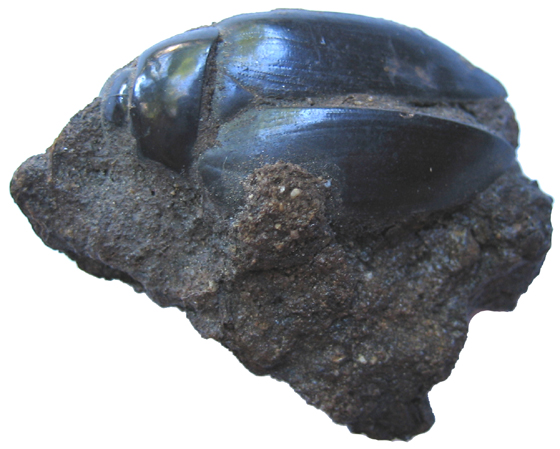
 |
 |
Chemical Preservation
 Beetle in Tar Sand Hydrophilus (Water Beetle) Pleistocene Tar Sands, California |
|
Rancho La Brea within the city of Los Angeles is one of the richest deposits of ice aged animals. The sabre-toothed cat Smilodon fatalis, the imperial mammoth Mammuthus imperator, the American mastodon Mammut americanum, and the giant ground sloth Glossotherium harlani are just some of the ice aged mammals that capture the public's imagination. However, hundreds of plant and animal species have been found trapped within these asphalt deposits providing a window into a North American Pleistocene ecosystem. Most of the fossils excavated at Rancho La Brea are carbon dated at between 11,000 and 38,000 years old. The asphalt rich sediments that contain this concentration lagerstatte were deposited during the last ice age (Wisconsinan Glaciation), which places them in the Upper Pleistocene Epoch. Shallow asphalt pools formed animal traps during the summer. During the winter these pools may have solidified. As seasons changed, heat from the summer sun would once again set the traps for foraging herbivores. Interestingly, there is a preservation bias for carnivores, young and maimed individuals. Young and maimed animals were more susceptible to becoming trapped in the asphalt pools. Scavengers were attracted to the carcasses accumulating in the pools. Although soft tissue is not preserved the bones retain much of their original composition. Rapid burial followed by asphalt permeation accounts for the excellent bone preservation (Nudds & Selden, 2008, p 262-268). The bones are black with tar and have the smell of petroleum. Scientists have extracted DNA from the bones to compare these extinct organisms with their living relatives (Prothero, 2004, p. 9). *Note: Rancho La Brea literally translates to "the tar ranch". The naturally occurring petroleum based substance is more properly referred to as asphalt (Nudds & Selden, 2008, p. 262).
Nudds, J.R. & Selden P.A. (2008). Fossil Ecosystems of North America: A Guide to the Sites and Their Extraordinary Biotas. Chicago: University of Chicago Press. Prothero, D.R. (2004). Bringing Fossils to Life: An Introduction to Paleobiology [2nd edition]. New York: McGraw-Hill. Rich P.V., Rich T. H., Fenton, M.A., & Fenton, C.L. (1996). The Fossil Book: A Record of Prehistoric Life. Mineola, NY: Dover Publications, Inc. |










